翻译理论与实践(1)
- 格式:doc
- 大小:60.50 KB
- 文档页数:6
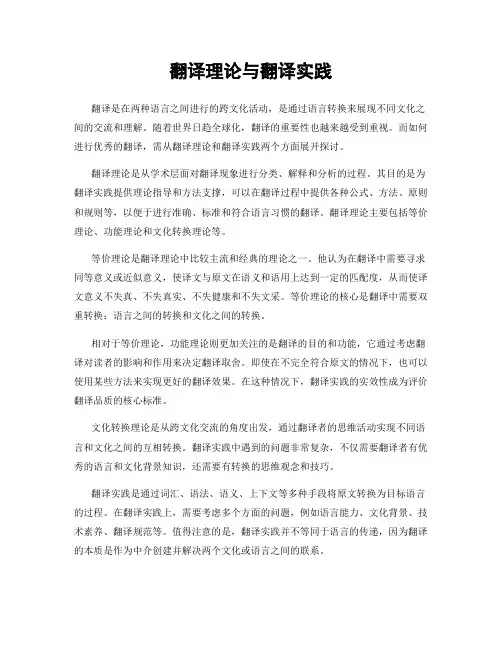
翻译理论与翻译实践翻译是在两种语言之间进行的跨文化活动,是通过语言转换来展现不同文化之间的交流和理解。
随着世界日趋全球化,翻译的重要性也越来越受到重视。
而如何进行优秀的翻译,需从翻译理论和翻译实践两个方面展开探讨。
翻译理论是从学术层面对翻译现象进行分类、解释和分析的过程。
其目的是为翻译实践提供理论指导和方法支撑,可以在翻译过程中提供各种公式、方法、原则和规则等,以便于进行准确、标准和符合语言习惯的翻译。
翻译理论主要包括等价理论、功能理论和文化转换理论等。
等价理论是翻译理论中比较主流和经典的理论之一。
他认为在翻译中需要寻求同等意义或近似意义,使译文与原文在语义和语用上达到一定的匹配度,从而使译文意义不失真、不失真实、不失健康和不失文采。
等价理论的核心是翻译中需要双重转换:语言之间的转换和文化之间的转换。
相对于等价理论,功能理论则更加关注的是翻译的目的和功能,它通过考虑翻译对读者的影响和作用来决定翻译取舍。
即使在不完全符合原文的情况下,也可以使用某些方法来实现更好的翻译效果。
在这种情况下,翻译实践的实效性成为评价翻译品质的核心标准。
文化转换理论是从跨文化交流的角度出发,通过翻译者的思维活动实现不同语言和文化之间的互相转换。
翻译实践中遇到的问题非常复杂,不仅需要翻译者有优秀的语言和文化背景知识,还需要有转换的思维观念和技巧。
翻译实践是通过词汇、语法、语义、上下文等多种手段将原文转换为目标语言的过程。
在翻译实践上,需要考虑多个方面的问题,例如语言能力、文化背景、技术素养、翻译规范等。
值得注意的是,翻译实践并不等同于语言的传递,因为翻译的本质是作为中介创建并解决两个文化或语言之间的联系。
一个好的翻译需要翻译者结合翻译理论和翻译实践进行切实可行的操作。
因此,好的翻译一定是理论和实践相结合、以实际效果为导向的翻译。
翻译者需要通过翻译理论来指导自己的翻译实践,同时在实际操作中总结出适合自身的方法和技巧。
值得一提的是,翻译理论和翻译实践是相互交织着的。

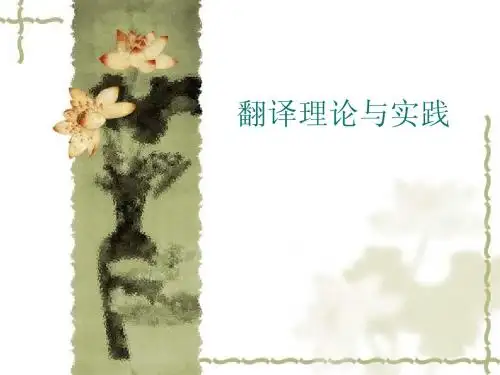
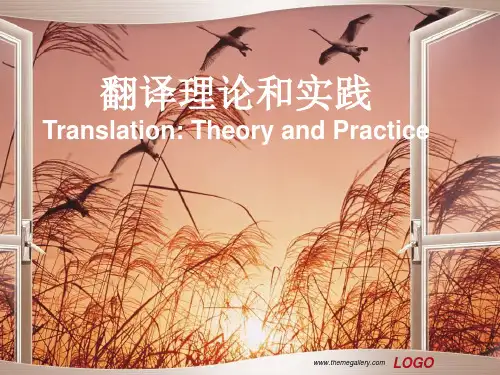
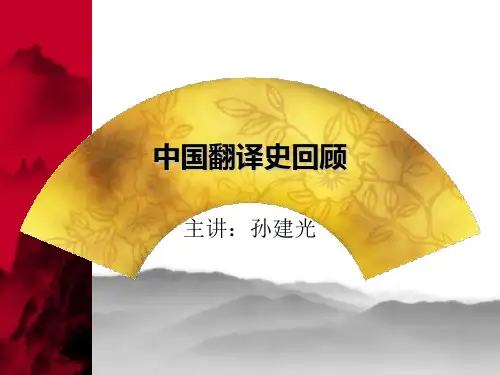
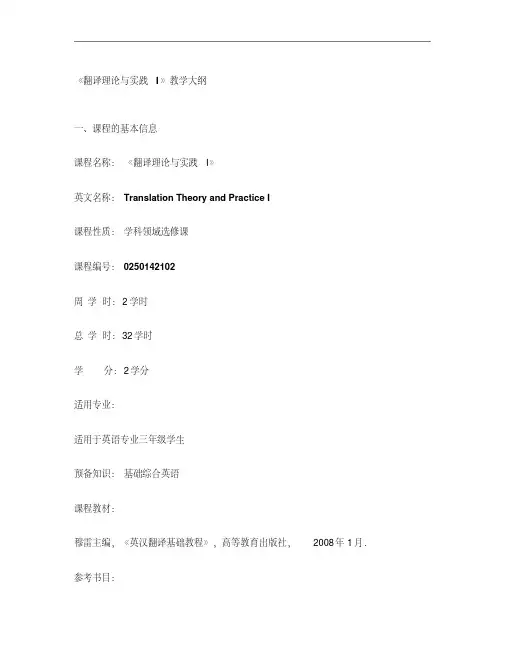
《翻译理论与实践I》教学大纲一、课程的基本信息课程名称:《翻译理论与实践I》英文名称:Translation Theory and Practice I课程性质:学科领域选修课课程编号:025*******周学时:2学时总学时:32学时学分:2学分适用专业:适用于英语专业三年级学生预备知识:基础综合英语课程教材:穆雷主编,《英汉翻译基础教程》,高等教育出版社,2008年1月.参考书目:[1] 张培基主编,《英汉翻译教程》(修订版),上海外语教育出版社出版,2009年.[2] 古今明编著,《英汉翻译基础》,上海外语教育出版社出版,1997年.[3] 刘全福编著,《英汉语言比较与翻译》,高等教育出版社出版,2011年.考核方式:考查制定时间:2013年10月制定二、课程的目的与任务《翻译理论与实践I》课程是英语专业高年级翻译系列课程中的一门专业选修课,面向英语专业本科三年级学生(第五学期)开授。
该课程由翻译理论和实践两部分组成。
翻译理论主要包括翻译的标准与原则,翻译的功能,翻译过程中对原文旨意、风格的理解与分析,以语义翻译和交际翻译为主的各种翻译方法,文化差异对翻译等值的影响等等。
通过对这些翻译理论的介绍,期望学生对国内外影响较大的翻译理论、流派及代表人物有一定的了解,并能够应用相关理论指导自己的翻译实践。
翻译实践课的主要内容是进行与翻译理论同步的翻译实践,通过大量翻译习练使学生熟悉各种翻译技巧并培养学生的文体意识,增强其对忠实传达原文旨意和风格的重要性的认识,以及对中英语言和文化差异对翻译影响的认识,进而全面提高其实际翻译能力。
《翻译理论与实践I》课程以英译汉为主。
三、课程内容及学时分配章节内容学时第一章翻译概述 4 第二章英汉语言文化比较 4 第三章理解原文 2 第四章基本翻译技巧 6 第五章英语词汇的汉译 4 第六章英语句子的汉译 6 第七章英语篇章的汉译 6合计32第一章翻译概述(4学时)一、本章基本要求1.了解翻译的定义;2.了解翻译的过程;3.理解并掌握翻译的标准;4.理解国内外具有代表性的翻译思想;5.了解对一名翻译人员的基本要求。
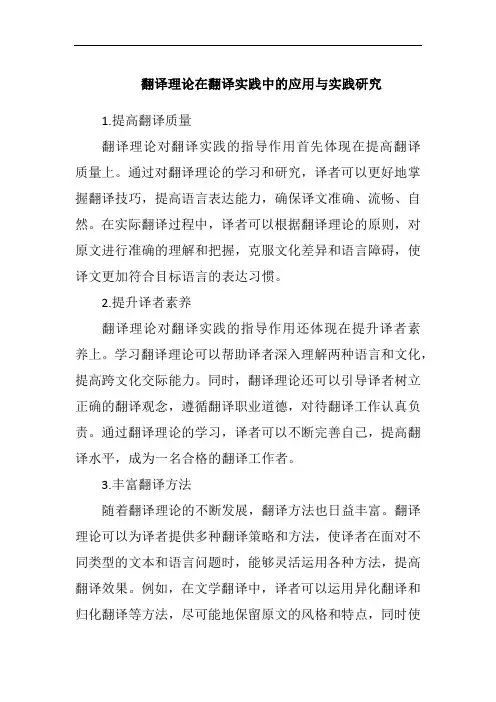
翻译理论在翻译实践中的应用与实践研究1.提高翻译质量翻译理论对翻译实践的指导作用首先体现在提高翻译质量上。
通过对翻译理论的学习和研究,译者可以更好地掌握翻译技巧,提高语言表达能力,确保译文准确、流畅、自然。
在实际翻译过程中,译者可以根据翻译理论的原则,对原文进行准确的理解和把握,克服文化差异和语言障碍,使译文更加符合目标语言的表达习惯。
2.提升译者素养翻译理论对翻译实践的指导作用还体现在提升译者素养上。
学习翻译理论可以帮助译者深入理解两种语言和文化,提高跨文化交际能力。
同时,翻译理论还可以引导译者树立正确的翻译观念,遵循翻译职业道德,对待翻译工作认真负责。
通过翻译理论的学习,译者可以不断完善自己,提高翻译水平,成为一名合格的翻译工作者。
3.丰富翻译方法随着翻译理论的不断发展,翻译方法也日益丰富。
翻译理论可以为译者提供多种翻译策略和方法,使译者在面对不同类型的文本和语言问题时,能够灵活运用各种方法,提高翻译效果。
例如,在文学翻译中,译者可以运用异化翻译和归化翻译等方法,尽可能地保留原文的风格和特点,同时使译文符合目标语言的表达习惯。
4.促进翻译评价体系的完善翻译理论对翻译实践的指导作用还可以体现在促进翻译评价体系的完善上。
翻译理论可以为译者提供评价译文质量的标准和方法,使译者在翻译过程中有据可依,提高翻译质量。
同时,翻译理论还可以帮助翻译评审者和读者更好地评价译文的质量,确保翻译工作的公平、公正、公开。
总之,翻译理论在翻译实践中的应用与实践研究具有重要意义。
翻译理论对翻译实践具有指导作用,可以提高翻译质量、提升译者素养、丰富翻译方法和促进翻译评价体系的完善。
因此,译者应当重视翻译理论的学习和研究,将翻译理论运用到实际翻译工作中,不断提高自己的翻译水平,为我国翻译事业的发展做出贡献。
同时,翻译理论研究者也应关注翻译实践,结合实际翻译问题,不断丰富和发展翻译理论,为翻译实践提供更有针对性和实用性的指导。
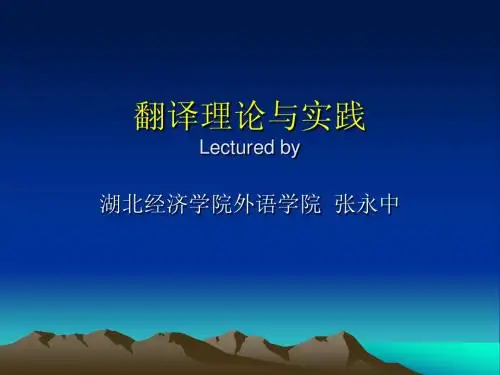
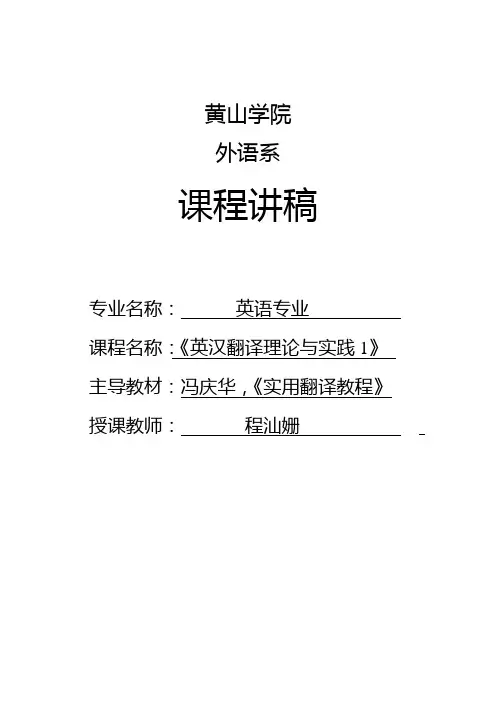
黄山学院外语系课程讲稿专业名称:英语专业课程名称:《英汉翻译理论与实践1》主导教材:冯庆华,《实用翻译教程》授课教师:程汕姗A Brief Introduction to Translation◇Teaching Contents:I.Discussion:●What is translation?●What is a successful translation?●What difficulties might occur in translating process?A.What is translation?1.Key words:source language(SL) / receptor language / target language(TL); reproduce; message /information; equivalence / correspondence2.Nature of translationTranslation consists in reproducing in the receptor language the closest naturalequivalent of the source language message, first in terms of meaning and secondly interms of style. (Eugene A. Nida)德国译学教授Wolfram Wilss 在The Science of Translation:Problems & Methods一书中说:Translation is not simply a matter of seeking other words withsimilar meaning, but of finding appropriate ways of saying things in another language.Translating is always meaning-based, i.e. it is the transfer of meaning instead of formfrom the source language to the target language.(翻译不只是在另一种语言中寻找意义相似的其他词语,而是寻找表达事物的适当方式。
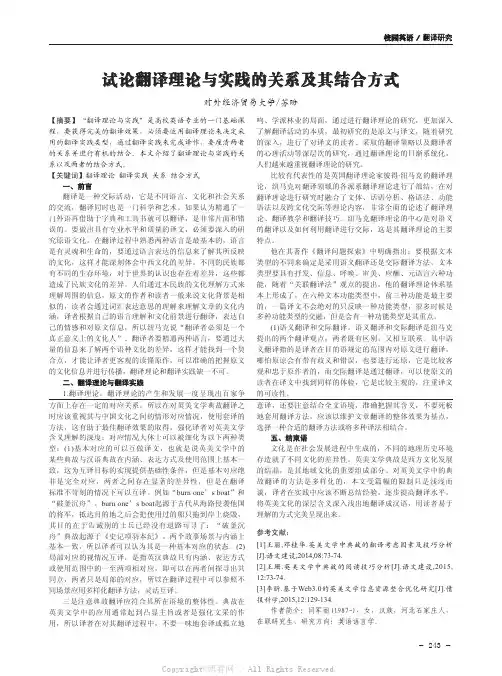
校园英语 / 翻译研究试论翻译理论与实践的关系及其结合方式对外经济贸易大学/苏盼【摘要】“翻译理论与实践”是高校英语专业的一门基础课程,要获得完美的翻译效果,必须要运用翻译理论来决定采用的翻译实践类型,通过翻译实践来完成译作,要厘清两者的关系并进行有机的结合。
本文介绍了翻译理论与实践的关系以及两者的结合方式。
【关键词】翻译理论 翻译实践 关系 结合方式一、前言翻译是一种交际活动,它是不同语言、文化和社会关系的交流,翻译同时也是一门科学和艺术。
如果认为精通了一门外语再借助于字典和工具书就可以翻译,是非常片面和错误的。
要做出具有专业水平和质量的译文,必须要深入的研究原语文化。
在翻译过程中熟悉两种语言是最基本的,语言是有灵魂和生命的,要通过语言表达的信息来了解其所反映的文化,这样才能深刻体会中西文化的差异。
不同的民族都有不同的生存环境,对于世界的认识也存在着差异,这些都造成了民族文化的差异。
人们通过本民族的文化理解方式来理解周围的信息,原文的作者和读者一般来说文化背景是相似的,读者会通过词汇表达意思的理解来理解文章的文化内涵,译者根据自己的语言理解和文化前景进行翻译,表达自己的情感和对原文信息,所以纽马克说“翻译者必须是一个真正意义上的文化人”。
翻译者要精通两种语言,要通过大量的信息来了解两个语种文化的差异,这样才能找到一个契合点,才能让译者更客观的读懂原作,可以准确的把握原文的文化信息并进行传播,翻译理论和翻译实践缺一不可。
二、翻译理论与翻译实践1.翻译理论。
翻译理论的产生和发展一度呈现出百家争鸣、学派林业的局面,通过进行翻译理论的研究,更加深入了解翻译活动的本质,最初研究的是原文与译文,随着研究的深入,进行了对译文的读者、采取的翻译策略以及翻译者的心理活动等深层次的研究,通过翻译理论的日渐系统化,人们越来越重视翻译理论的研究。
比较有代表性的是英国翻译理论家彼得·纽马克的翻译理论,纽马克对翻译领域的各派系翻译理论进行了部结,在对翻译理论进行研究时融合了文体、话语分析、格语法、功能语法以及跨文化交际等理论内容,非常全面的论述了翻译理论、翻译教学和翻译技巧。
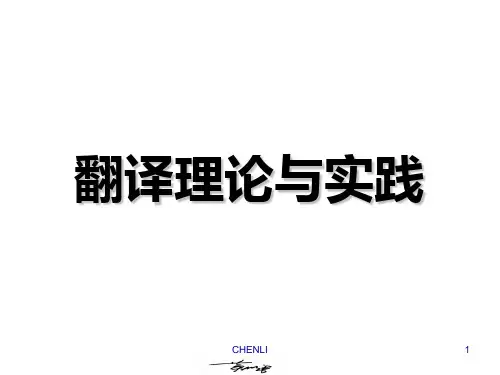
一、翻译的基本理论复习题〔一〕列举至少三种翻译标准〔中、西均可〕,并指出是由谁提出的。
中国的:严复,信雅达三字标准; 林语堂:忠实,通顺,美的标准傅雷,神似;茅盾:意境论;钱钟书:化境赵秀明:韵味说外国的:泰特勒的三原则〔1.译文应完全复写出原作的思想 2.译文的风格和笔调应与原文的性质相同3.译文应和原作同样流畅〕费道罗夫的等值论:等值即译文和原文等值,表现在读者看了原文和译文之后,其感受的等值性。
奈达的等效理论奈达从社会语言学和语言交际功能观点,提出“最接近的,自然的等效翻译〞概念,认为翻译必须以接受者服务为中心,要根据不同接受者的要求对译文作相应调整。
二〕翻译的主要方法有_直译_和_意译_。
“直译〞就是忠实的再现原作思想内容,并尽量保存原作语言形式的表现方法。
原文如在形、义上与译语全同或是基本相同的可以直译,原语中的比喻或形象能为译语读者所接受的有时也可以采用直译。
“意译〞是忠实传达原作思想内容而放弃原作形式。
多强调译文的效果,不求表层次形式对应,只求语言在深层次中的对应。
不是主观臆断,是以不背离原文为限度,注意翻译时对原文结构的调整,用规X的译语表达。
〔三〕列举你所掌握的翻译技巧。
技巧是翻译的具体策略,在直译和意译两大类翻译方法之下,具体的翻译技巧有分切、转换、转移、还原、阐释、融合、引申、反转、替代、拆离、增补、省略、重复、重组、移植等。
再概括起来,可以归结为增、减、移、换四大策略。
〔四〕列举中、西翻译史上著名翻译家至少十位。
傅雷,季羡林,草婴,鲁迅,杨绛,朱生豪,X谷若,诺思,查普曼,费洛里欧,何兰德,阿瑟伟利,弗兰茨库恩,玄奘、义净、徐寿、李善兰、赵元益、卞之琳、叶水夫、黄龙、茅盾;乔叟、西塞罗、哲罗姆、阿尔弗雷德国王、波伊提乌、诺思〔五〕谈谈翻译的困难〔至少两点〕。
首先理解的困难。
汉语和英语都是很发达的语言,以表达丰富细致著称,要理解的准确必须处处细致。
Eg:in the seventh heaven不可按表面译为“升天〞本意是“非常高兴〞:翻译方法的选择是另一困难。
翻译理论与实践1(英译汉)实战练习 15篇1 翻译理论与实践1(英译汉)实战练习 15篇1.The Policy of Mass Media1) Life is indeed full of problems on which we have to make decisions as citizens or as private individual.2) But neither the real difficulty of these decisions nor their true and disturbing challenge to each individual can often be communicated through the mass media.3) The disinclination to suggest real choice which is to be found in the mass media is not simply the product of a commercial desire to keep the customers happy.4) The organs of the Establishment however well―intentioned they may be have a vested interest in ensuring that the public boat is not violently rocked and will so affect those who work within the mass media that they will be led insensibly towards forms of production which though they go through the motions of dispute and inquiry do not break through the skin to where such inquires might really hurt.5) They will tend to move when exposing problems well within the acceptedcliché―assumptions of democratic society and will tend neither radically to question these clichés nor to make a disturbing application of them to features of contemporary life2. The American and the English1) Of the intrinsic differences that separate American from English the chief have their roots inthe obvious disparity between the environment and traditions of the American people since the seventeenth century and those of the English.2) The latter have lived under a relatively stable social order and it has impressed upon their souls their characteristic respect for what is customary and of good report.3) Until the World War brought chaos to most of their institutions their whole lives were regulated perhaps more than those of any other people save the Spaniards by a regard for precedent.4) The Americans though partly of the same blood have felt no such restrain and acquired no such habit ofconformity.5) On the contrary they have plunged to the other extreme for the conditions of life in their country have put a high value upon the precisely opposite qualities of curiosity and daring and so they acquired that character of restlessness that impatience of forms that disdain of the dead hand which now broadly marks them.3. The Education of Humanists1)The education of humanists cannot be regarded as complete or even adequate without exposure in some depth to where things stand in the various branches of science particularly in the areas of our ignorance.2)Physics professors most of them look with revulsion on assignments to teach their subjects to poets.3) The liberal arts faculties for their parts will continue to view the scientists with suspicion and apprehension. 4) But maybe a new set of courses dealing systematically with ignorance in science will take hold.5) The scientists might discover in it a new and subversive technique for catching the attention of students driven by curiosity delighted and surprised to learn that science is exactly as some scientists described it: an “endless frontier.”6) The humanists for their part might take considerablesatisfaction in watching their scientific colleagues confess openly to not knowing everything about everyone.7) And the poets on whose shoulders the future rests might late nights thinking things over begin to see some meanings that elude the rest of us.4. . American Study1) The scientific interest of American history centered in national character and in the workings of a society destined to become bast in which individuals were imp0rtant chiefly as types.2) Although this kind of interest was different from that of European history it was at least as important to the world.3) Should history ever become a true science it must expect to establish its laws not from the complicated story of rival European nationalities but from the economical evolution of a great democracy.4) North America was the most favorable field on the globe for the spread of a society so large uniform and isolated as to answer the purposes of science.5) There a single homogeneous society could easily attain proportions of three or four hundred million persons under conditions of undisturbed growth.6) In Europe or Asia undisturbed social evolution had been unknown.7) Without disturbance evolution seemed to cease.8) Wherever disturbance occurred permanence was impossible.9) Every people in turn adapted itself to the law of necessity.5. Jack London1) Life itself led London to reject this approach in his writing.2) He knew what it meant to be one of the disinheritedto be chained to the deadening routine of the machine and to soul-destroying labor for an insufficient reward.3) Consequently he swept aside not only the literature that pretended that ours is a society of sweetness and light but also that which contended that the inculcation of the spirit of Christian fellowship would put an end to class controversy.4) He did not oppose labor organization nor balk at the strike as a weapon of labor; rather he took his heroes and heroines from the labor movement and wove his plots within their struggles.5) He poured into his writings all the pain of his life the fierce hatred of the bourgeoisie that it had produced in him and the conviction it had brought to him that world could be made a better place to live in if the exploited would rise up and take the management of society out of the hands of the exploiters.6. President Carter1) President Carter has been calling his closest advisers together for what is called as a hard reappraisal of his administration’s troubles but who will tell him the truth? 2) You can almost put it down as a general rule in this town that presidents often invite “honest criticism” from their aides but seldom get it and usually don’t follow it when they do.3) The reasons for this are not obscure.4) The Oval Office is the most frightening room inAmerica.5) It imposes a kind of respect on most visitors and even those legislative lions who roar against the president on Capital Hill tend to usually lower their voices and follow their prepared speeches when they walk through the White House door.6) Few While House aides dare to say anything against the president without betraying their fears.7) Even Henry Kissinger who is not an excessively modest or silent man hesitated to face President Nixon with the disaster he knew lay ahead.7. On “Mein Kampf”1) Mein Kampf’s theme song recurring again and again is race race purity race supremacy though nowhere did Hitler attempt to define race.2) It wasnever intended by Nature Hitler claims that all races should be equal any more than individuals are equal.3) Some are created superior to others.4) The Germans as the world’s strongest race should rule over the inferior through having the habitat of the highest race extended and scattered Germanic peoples united under one rule.6) The vast expansion visualized by Hitler would takeplace principally at the expense of other races.7) To attain the objectivesset by his soaring ambition Hitler proposes three methods: propagandadiplomacy and force. 8) Nowhere in Mein Kampf is the author more revealing of himself and his tactics than in his discussionof propaganda techniques―correctly believed by him to be one of the Nazis’ most effective and formidable weapons.8. How to Write Clearly1) I have never had much patience with the writers who claim from thereader an effort to understand their meaning.2) You have only to go to great philosophers to see that it is possible to express with lucidity the mostsubtle reflections.3) One cause of obscurity is that many writers think not before but as they write.4) The pen originates the thought.5) Thedisadvantages of this and indeed it is a danger against which the author mustbe always on his guard is that there is a sort of magic in the written word.6) The idea acquires substance by taking on a visible nature and then stands inthe way of its own clarification.7) But this sort of obscurity merges veryeasily into the willful.8) Some writers who do not think clearly are inclinedto suppose that their thoughts have a significance greater than at first sight appears.9) It is flattering to believe that they are too profound to be expressed so clearly that all who run may read and very naturally it does not occur to such writers that the fault is with their own minds which have notthe faculty of precise reis with their own minds which have not the faculty of precise reflection.感谢您的阅读,祝您生活愉快。
一、词语翻译选择(1分*15)练习一:1. 姜汁皮蛋: Preserved Eggs in Ginger Sauce2. 凉拌金针菇: Golden Mushroom with Vegetable3. 五香牛肉: Spiced Beef4. 盐焗鸡:Salt Baked Chicken5. 素鸭: Dried Tofu6. 电脑盲: computer illiterate7. 翻两番:quadruple8. 光谷:optical valley9. 黑客:hacker 10. 排外主义: exclusivism练习二:1. 我打算买辆汽车,可心里一直犹豫不定,不知道买那个牌子的好。
I’m thinking of buying a car, but I’m still of two minds. I can hardly decide as to which brand I should take.2. 老板这几天沉默寡言,看起来好像是心事重重的。
The boss is quite down these days. He seems to have something weighing heavily on his mind.3. 千万别得罪他,他会对你怀恨在心的。
Take care not to offend him, or he’ll bear you a grudge.4. 当老板问起是谁把消息说出去的时候,他们两个人相互推卸责任。
When the boss was asking who had disclosed the news, the two of them began to pass the buck to each other.5. 这几天不知是什么事把我搞得心烦意乱的。
I don’t know what has set my nerves on edge these days.6. 火上浇油。
To add fuel to the fire.7. 混水摸鱼。
Fish in troubled waters.8. 小题大做。
Make a mountain out of a molehill.9. 口是心非。
Say yes and mean no.10. 胸有成竹。
To have a well-thought plan before doing something.二、文化词语翻译选择(1分*15)饮食词语:就刀法而言常见的有:切丝(shred)、切片(slice)、切丁(dice)、切柳(fillet)、切末(mince)、捣烂(mash);就其烹饪方法总的说来有以下十一种:炒(stir-frying),“炒蛋”的英语是scrambled egg,不译fried egg;煎(pan-frying),如:“煎鸡蛋”pan-fried egg;爆(quick-frying),如:“爆大虾”quick-fried shrimps;炸(deep-frying),如:“五香炸鸡翅”deep-fried chicken wing with spicy flavor;烧(braising),用酱油来烧,叫“红烧”braising with soy sauce或braising in brown sauce;煮(boiling),“煮”还可分“速煮”instant boiling和“快煮”quick boiling;蒸(steaming),如:“荷叶粉蒸肉”steamed flour-coated pork wrapped in lotus leaves;煲/炖/煨/焖/卤(simmering/stewing),如:“炖栗子鸡”stewedchicken with chestnuts,“煨牛肉”simmered beef;熏(smoking),如:“熏山鸡”smoked pheasant;烘烤铁烧(铁烧broiling或grilling,烧烤roasting,烘baking),如:“奶油烧鱼柳”grilled fish with butter sauce,“铁烧牛扒”grilled beefsteak,“烧乳猪”roast suckling pig;白灼(scalding或blanching),如:“白灼海螺片”scalded sliced conch。
练习一:1.劳动人事部:Ministry of Labor and Personnel2.对外经济贸易部:Ministry of Foreign Economic Relations and Trade3.卫生部:Ministry of Public Health4.团委:Youth League Committee5.财政厅:Department of Finance6.公安局:Bureau of Public Security7.主任护师:professor of nursing8.(副)编审:(associate) professor of editorship9.副)译审:(associate) professor of translation10.(助理)翻译:(assistant) translator11.艺术总监:Chief Art Officer (CAO)市场总监:Marketing Director 13.副主任:deputy director副处长:deputy division chief 15.副科长:deputy section chief.公关部经理:Manager for public Relations 17.人事部经理:personnel Manager博士后:Post-doctor19博士:Doctor 硕士:Master学士:Bachelor22双学士:Dual Bachelors 进士:Imperial Scholar24状元:Champion Scholar榜眼:Runner-up26探花:Second Runner-up举人: juren, the selected talents 练习二:西湖龙井:Xihu Longjing Tea (Green Tea)大红袍:Dahongpao Tea (Wuyi Mountain Rock Tea)安溪铁观音:Anxi Tieguanyin Tea (Oolong Tea)台湾人参乌龙Taiwan Ginsen Oolong Tea 陈年普洱Aged Pu 'er Tea 大白毫White Milli- Silver Needle Tea 茉莉花茶Jasmine Tea 立顿红茶Lipton Black Tea 冻顶乌龙Dongding Oolong Tea 绿毛峰Lvmaofeng Tea 八宝茶Assorted Chinese Herbal Tea 菊花茶Chrysanthemum Tea 冰茶Iced Tea 港式奶茶Hot Tea, HK Style 巧克力奶茶Chocolate Milk Tea 冰巧克力奶茶Iced Chocolate Milk Tea 草莓奶茶Strawberry Milk Tea 菠萝果茶Pineapple Tea 菠萝冰茶Iced Pineapple Tea 奇异果冰茶Iced Kiwi Tea练习三:辣子鸡丁diced chicken with hot pepper青椒肉丝shredded pork with green pepper鲜菇肉片sliced pork with fresh mushroom莲藕猪肉汤stewed pork soup with lotus root米粉蒸肉steamed pork with rice flour红烧牛肉braised beef with brown sauce 煸炒腰花stir-fired kidney 烤乳猪roasted suckling pig 白灼基围虾scalded shrimps 冬菇炒肉丝sautéed shredded chicken with bean paste酱爆鸡丁quick fried diced chicken with bean paste蚝油菜心green cabbage in oyster sauce糖醋排骨crisp shrimp with rice wine sauce蚂蚁上树stir-fried vermicelli with minced pork麻婆豆腐mapo tofu, stir-fried bean curd in hot sauce宫保鸡丁kungbao chicken, stir-fried chicken dices with peanuts and chili红烧狮子头stewed pork ball in brown sauce全家福happy family, a combination of shrimps, pork, beef, chicken and minced vegetables with brown sauce三、俗语翻译选择(1分*15)练习一:1.城门失火,殃及池鱼A fire on the city wall brings disaster to the fish in the moat. 2毛遂自荐To volunteer one’s service.3. 锱铢必较To haggle over every penny.4. 四面楚歌To be besieged on all sides.5. 初出茅庐At the beginning of one’s career.6. 粗枝大叶To be crude and careless.7. 开门见山To come straight to the point.8. 攻其不备To strike sb. when he is unprepared.9. 扬眉吐气To feel proud and elated.10. 趁热打铁To strike while the iron is hot.练习二:11.路遥知马力,日久见人心As a long road tests horse’s strength, soa long task proves a person’s heart.12. 徐庶入曹营,一言不发Hold one’s tongue13. 骑着毛驴看唱本,走着瞧Let’s wait and see.14. 嫁鸡随鸡,嫁狗随狗A woman must follow her husband’s lot and position.15. 人无远虑,必有近忧He lives unsafely that looks too near on things.16. 天有不测风云,人有旦夕祸福Sudden storms spring up in nature, and the fortunes of men may change overnight.四、商务英语(EBE)翻译选择(1分*15)练习一:1.询问函尊敬的约翰逊先生:请问贵公司能否报一份为我公司餐厅和办公室提供新近距以及运输安装的价格?1. 餐厅面积大约是30米×20米,我们需要6张餐桌,每张配有4把椅子,从4号系列中挑选。